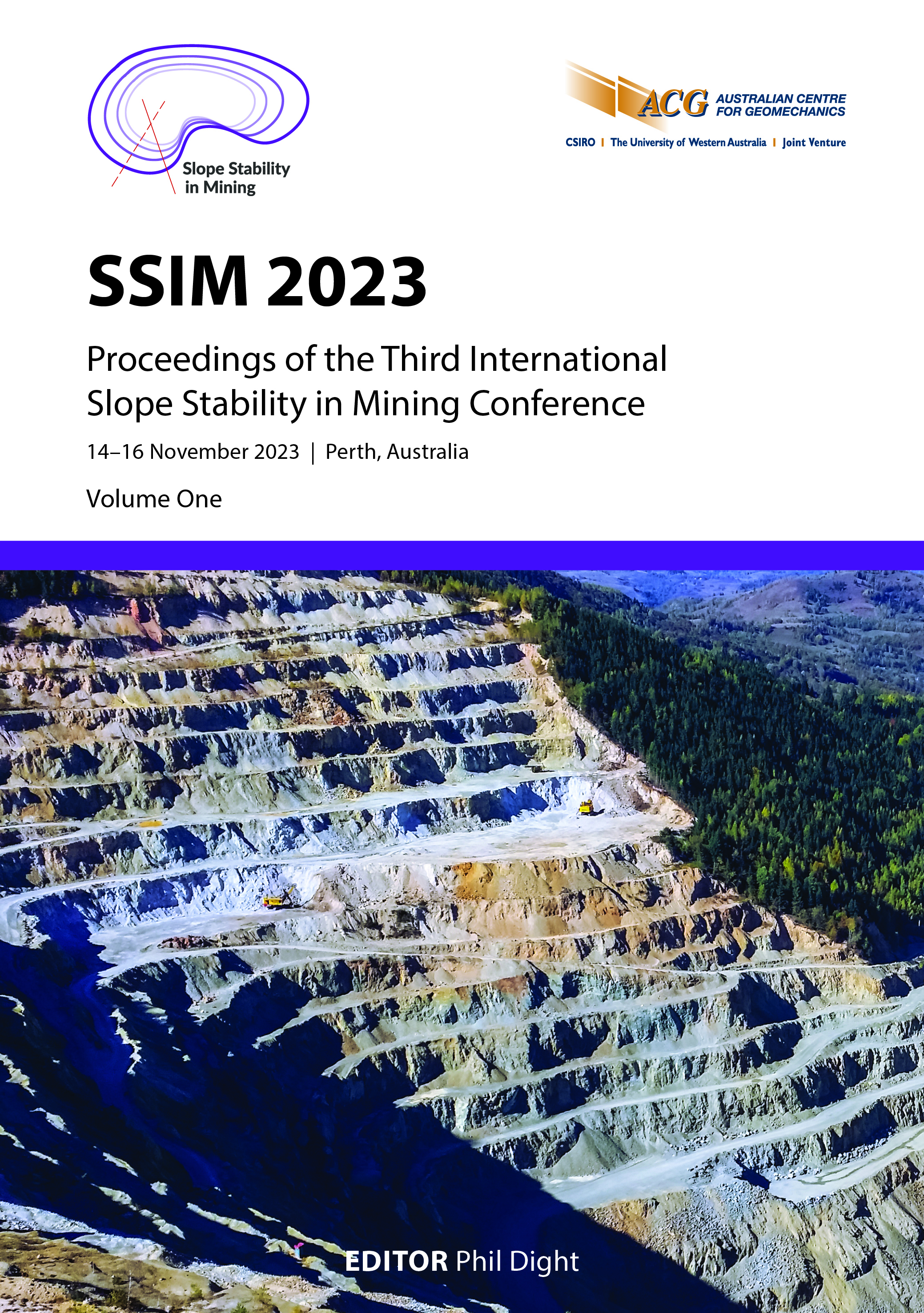Challenges of characterising a highly altered and variable rock mass for open pit slope design optimisation

|
Authors: Darakjian, T; Luck, S; Luck, D; Xu, C; Moffitt, K; Nicoll, S; Tennant, D; Pothitos, F |
DOI https://doi.org/10.36487/ACG_repo/2335_21
Cite As:
Darakjian, T, Luck, S, Luck, D, Xu, C, Moffitt, K, Nicoll, S, Tennant, D & Pothitos, F 2023, 'Challenges of characterising a highly altered and variable rock mass for open pit slope design optimisation', in PM Dight (ed.), SSIM 2023: Third International Slope Stability in Mining Conference, Australian Centre for Geomechanics, Perth, pp. 359-372, https://doi.org/10.36487/ACG_repo/2335_21
Abstract:
Geotechnical characterisation is generally carried out by subdividing a rock mass into a number of unique geotechnical domains, each exhibiting similar geotechnical properties. Geotechnical data for each domain are then analysed to develop representative parameters for each domain. This approach is not optimal for rock masses that have significant local-scale variability in geotechnical character. This paper documents the approach used to consider the high degree of spatial variability in geotechnical properties for the Lihir Mine, located in Papua New Guinea. The Lihir Mine is situated within the Luise volcanic crater, part of a volcanic island arc chain within the New Ireland arc-trench complex, southwest of an inactive subduction zone. The Luise volcano has previously been interpreted as a mafic to intermediate volcano, with an underlying porphyry system. Following volcanic sector collapse, the lithostatic load was rapidly decreased. This led to boiling of mineralised fluids and resulted in the formation of an epithermal gold deposit (Blackwell et al. 2010). Maar-diatreme activity then continued within the caldera, leading to the formation of diatreme eruptive centres and crater lake sediments. The geological history has resulted in a complex geological and structural environment with a high degree of geotechnical variability. Geotechnical characterisation has involved the use of geostatistical block modelling approaches to better identify the spatial variability of geotechnical properties within each geotechnical domain. The use of block modelling tools has allowed for greater resolution of input parameters for both 2D and 3D stability analyses.
Keywords: caldera, diatreme, ordinary kriging, 3D modelling, continuity, data spatial distribution, block model, stability analysis, geotechnical characterisation, slope optimisation, slope stability, weak rocks
References:
Bieniawski, ZT 1976, ‘Rock mass classification in rock engineering’, in ZT Bieniawski (ed.), Symposium Proceedings of Exploration for Rock Engineering, vol. 1, pp. 97–106, A.A. Balkema, Cape Town.
Bieniawski, ZT 1989, Engineering Rock Mass Classifications, Wiley, New York.
Blackwell, JL, Cooke, DR, McPhie, J & Simpson, KA 2010, ‘Lithofacies associations and evolution of the volcanic host succession to the Minifie ore zone, Ladolam gold deposit, Lihir Island, Papua New Guinea’, Economic Geology, vol. 109, no.4, pp. 1137–1160,
Carman, GD 1994, Genesis of the Ladolam Gold Deposit, Lihir Island, Papua New Guinea, Doctoral dissertation, Monash University, Melbourne.
Cole, JW, Milner, DM & Spinks, KD 2005, ‘Calderas and caldera structures: a review’, Earth-Science Reviews, vol. 69, no. 1–2, pp. 1–26,
Davies, RH & Ballantyne, GH 1987, ‘Geology of the Ladolam gold deposit Lihir Island, Papua New Guinea’, Proceedings of the Pacific Rim Congress 87, Australasian Institute of Mining and Metallurgy, Melbourne, pp. 943–949.
Goulet, A, Grenon, M & Hadjigeorgiou, J 2022, ‘Understanding the impact of alteration on rock mass strength’, Geotechnical and Geological Engineering, vol. 40, no. 5, pp. 2533–2552.
Hoek, E, Carter, TG & Diederichs, MS 2013, ‘Quantification of the geological strength index’, Proceedings of the 47th US Rock Mechanics/Geomechanics Symposium, American Rock Mechanics Association, Alexandria.
ISRM 2007, The ISRM Suggested Methods for Rock Characterisation, Testing and Monitoring: 1974-2007, Springer Cham, Cham.
Itasca Consulting Group Inc. 2019, FLAC3D — Fast Lagrangian Analysis of Continua in Three-Dimensions, version 6.0, computer software, Itasca, Minneapolis, https://www.itascacg.com/learning/tutorials/flac3d-6-0-built-in-model-generation-tools-and-workflow
Lawlis, EEC 2020, Geology of the Kapit NE and Coastal Ore Zones, Lihir Gold Deposit, Papua New Guinea, Doctoral dissertation, University of Tasmania, Hobart.
Maptek 2022, Vulcan, version 2022.4.1, computer software, Maptek, Denver.
Moyle, AJ, Doyle, BJ, Hoogvliet, H & Ware, AR 1990, ‘Ladolam gold deposit, Lihir Island’, Australasian Institute of Mining and Metallurgy, vol. 14, pp. 1793–1805.
Rocscience Inc 2021a, Dips, version 8.0, computer software, Rocscience Inc, Toronto, https://www.rocscience.com/software/dips
Rocscience Inc 2021b, RocPlane, version 4.0, computer software, Rocscience Inc, Toronto. https://www.rocscience.com/
software/rocplane.
Rocscience Inc 2021c, SWedge, version 7.0, computer software, Rocscience Inc, Toronto. https://www.rocscience.com/
software/swedge.
Rocscience Inc 2021d, Slide2, version 9.0, computer software, Rocscience Inc, Toronto. https://www.rocscience.com/software/slide
Sykora, S, Selley, D, Cooke, DR & Harris, AC 2018, ‘The structure and significance of anhydrite-bearing vein arrays, Lienetz orebody, Lihir gold deposit, Papua New Guinea’, Economic Geology, vol. 113, no. 1, pp. 237–270,
10.5382/econgeo.2018.4550.
WSP 2023, OBO, computer software, version 16.01, Golder Associates, Toronto.
© Copyright 2026, Australian Centre for Geomechanics (ACG), The University of Western Australia. All rights reserved.
View copyright/legal information
Please direct any queries or error reports to repository-acg@uwa.edu.au
View copyright/legal information
Please direct any queries or error reports to repository-acg@uwa.edu.au

